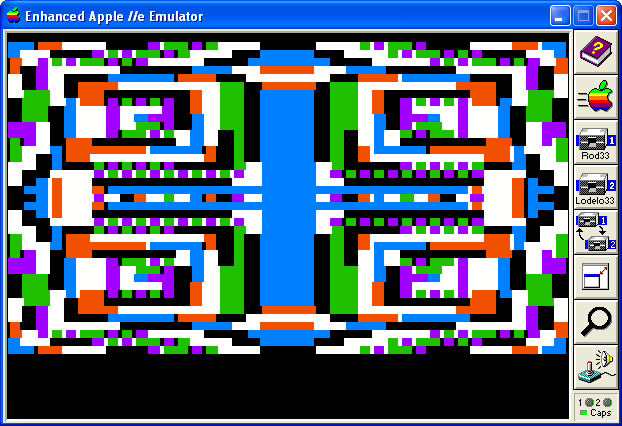

/* This demo program is loosely based on the following version of Rod's Color Pattern in C by Dr. John B. Matthews: http://home.roadrunner.com/~jbmatthews/apple2.html#rp1c Which in turn is based on Rod's Color Pattern, written in Basic by Randy Wigginton, which originally appeared on page 55 of the Red Book distributed by Apple Computer, Inc. circa 1978. It was described as "a simple but eloquent program. It generates a continuous flow of colored mosaic-like patterns in a 40 high by 40 wide block matrix. Many of the patterns generated by this program are pleasing to the eye and will dazzle the mind for minutes at a time." At any rate this particular version is for the hires display and isn't quite as spectacular as the lores version but is included anyway by way of a graphics demo. Bill Buckels December 2009 */ #include <stdlib.h> #include <string.h> #include <conio.h> #include <peekpoke.h> void setcrtmode(unsigned int CRTMODE) { /* note: the following constants must be hex values or cc65 complains that the constant is a long */ switch(CRTMODE) { case 0: POKE(0xc051,0); /* text */ POKE(0xc054,0); /* page 1 */ break; case 2: default: POKE(0xc057,0); /* hi res */ POKE(0xc055,0); /* page 2 */ POKE(0xc050,0); /* set graphics */ POKE(0xc052,0); /* full graphics */ } } /* provides base address for page2 hires scanlines */ unsigned HB[]={ 0x4000, 0x4400, 0x4800, 0x4C00, 0x5000, 0x5400, 0x5800, 0x5C00, 0x4080, 0x4480, 0x4880, 0x4C80, 0x5080, 0x5480, 0x5880, 0x5C80, 0x4100, 0x4500, 0x4900, 0x4D00, 0x5100, 0x5500, 0x5900, 0x5D00, 0x4180, 0x4580, 0x4980, 0x4D80, 0x5180, 0x5580, 0x5980, 0x5D80, 0x4200, 0x4600, 0x4A00, 0x4E00, 0x5200, 0x5600, 0x5A00, 0x5E00, 0x4280, 0x4680, 0x4A80, 0x4E80, 0x5280, 0x5680, 0x5A80, 0x5E80, 0x4300, 0x4700, 0x4B00, 0x4F00, 0x5300, 0x5700, 0x5B00, 0x5F00, 0x4380, 0x4780, 0x4B80, 0x4F80, 0x5380, 0x5780, 0x5B80, 0x5F80, 0x4028, 0x4428, 0x4828, 0x4C28, 0x5028, 0x5428, 0x5828, 0x5C28, 0x40A8, 0x44A8, 0x48A8, 0x4CA8, 0x50A8, 0x54A8, 0x58A8, 0x5CA8, 0x4128, 0x4528, 0x4928, 0x4D28, 0x5128, 0x5528, 0x5928, 0x5D28, 0x41A8, 0x45A8, 0x49A8, 0x4DA8, 0x51A8, 0x55A8, 0x59A8, 0x5DA8, 0x4228, 0x4628, 0x4A28, 0x4E28, 0x5228, 0x5628, 0x5A28, 0x5E28, 0x42A8, 0x46A8, 0x4AA8, 0x4EA8, 0x52A8, 0x56A8, 0x5AA8, 0x5EA8, 0x4328, 0x4728, 0x4B28, 0x4F28, 0x5328, 0x5728, 0x5B28, 0x5F28, 0x43A8, 0x47A8, 0x4BA8, 0x4FA8, 0x53A8, 0x57A8, 0x5BA8, 0x5FA8, 0x4050, 0x4450, 0x4850, 0x4C50, 0x5050, 0x5450, 0x5850, 0x5C50, 0x40D0, 0x44D0, 0x48D0, 0x4CD0, 0x50D0, 0x54D0, 0x58D0, 0x5CD0, 0x4150, 0x4550, 0x4950, 0x4D50, 0x5150, 0x5550, 0x5950, 0x5D50, 0x41D0, 0x45D0, 0x49D0, 0x4DD0, 0x51D0, 0x55D0, 0x59D0, 0x5DD0, 0x4250, 0x4650, 0x4A50, 0x4E50, 0x5250, 0x5650, 0x5A50, 0x5E50, 0x42D0, 0x46D0, 0x4AD0, 0x4ED0, 0x52D0, 0x56D0, 0x5AD0, 0x5ED0, 0x4350, 0x4750, 0x4B50, 0x4F50, 0x5350, 0x5750, 0x5B50, 0x5F50, 0x43D0, 0x47D0, 0x4BD0, 0x4FD0, 0x53D0, 0x57D0, 0x5BD0, 0x5FD0}; /* this version of fbox provides filled boxes in both hires palettes and conforms to the standard Apple II hires color numbers. it is not backwardly compatible due to my support for one palette only in the past. c'est la vie */ void hibox(x1,y1,x2,y2,drawcolor) int x1,y1,x2,y2,drawcolor; { /* draws a filled box to the color specified */ int packet = (x2-x1)+1; int temp,ctr; char *ptr; char c[2]; /* if on an odd byte boundary reverse color arg */ /* to match color mapping in the framebuffer */ if(x1%2!=0) { switch(drawcolor) { case 1 : drawcolor = 2; break; case 2 : drawcolor = 1; break; default: break; } } /* set the color */ switch(drawcolor) { case 8 : break; /* inverse video box */ case 7 : c[0]='\x7f'; c[1]='\x7f'; /* white ... everything */ break; case 6 : c[0]='\x2a'; c[1]='\x55'; /* green */ break; case 5 : c[0]='\x55'; c[1]='\x2a'; /* purple */ break; case 4: c[0]='\x00';c[1]='\x00'; /* black ... nothing */ break; case 3 : c[0]='\xff'; c[1]='\xff'; /* white ... everything */ break; case 2 : c[0]='\xaa'; c[1]='\xd5'; /* orange */ break; case 1 : c[0]='\xd5'; c[1]='\xaa'; /* blue */ break; default: c[0]='\x80';c[1]='\x80'; /* black ... nothing */ } y2++; /* now write the pixels */ while(y1<y2) { temp=HB[y1]; ptr = (char *)(temp+x1); for(ctr=0;ctr<packet;ctr++) { if(drawcolor!=8) { *ptr=c[0]; *ptr++; ctr++; if(ctr<packet) { *ptr=c[1]; *ptr++; } } else { *ptr^='\x7f'; /* xor in current palette */ *ptr++; } } y1++; } } int khit() { unsigned char *KP = (unsigned char*)0xC000; unsigned char c; /* read the keyboard buffer */ /* and return 0 if no character is waiting */ c = KP[0]; if(c<128)return 0; return (int)c; } void clearkey() { /* return the last key press */ unsigned char *KEYPRESS = (unsigned char*)0xC000; /* clear the last key press */ unsigned char *KEYCLEAR = (unsigned char*)0xC010; /* clear stragglers from the keyboard buffer */ while(KEYPRESS[0] > 127)KEYCLEAR[0]=0; } int hrod () { int i, j, k, w, fmi, fmk, color, c=0; for (w = 3; w < 51; w++) { for (i = 1; i < 20; i++) { for (j = 0; j < 20; j++) { k = i + j; color = (j * 3) / (i + 3) + i * w / 12; fmi = 40 - i; fmk = 40 - k; color = (color/2)&7; hibox( i-1, k*4, i, k*4+3, color); hibox( k-1, i*4, k, i*4+3, color); hibox( fmi-1, fmk*4, fmi, fmk*4 + 3,color); hibox( fmk-1, fmi*4, fmk, fmi*4 + 3,color); hibox( k-1, fmi*4, k, fmi*4+3,color); hibox( fmi-1, k*4, fmi, k*4+3,color); hibox( i-1, fmk*4, i, fmk*4+3,color); hibox( fmk-1, i*4, fmk, i*4+3,color); if ((c = khit()) > 0) { clearkey(); return c-128; } } } } if ((c = khit()) > 0) { clearkey(); c-=128; } return c; } int main() { setcrtmode(2); clearkey(); for (;;) { hibox(0,0,39,191,0); if (hrod()==27)break; } setcrtmode(0); setcrtmode(0); clrscr(); return EXIT_SUCCESS; } |